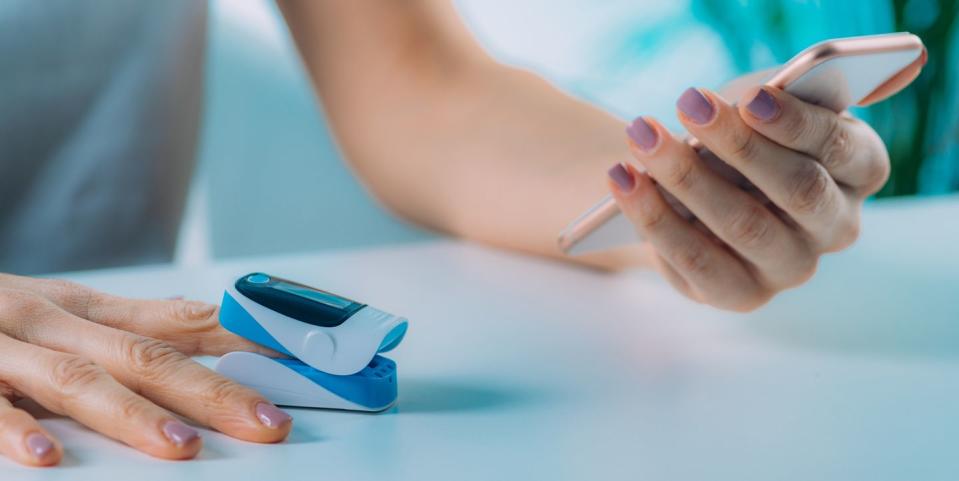What is a pulse oximeter and how does it work?

Pulse oximetry is a non-invasive test that is used to measure a patient’s oxygen saturation level, or the oxygen levels in their blood. It involves pulse oximeters, which are small medical devices that can detect when a patient’s oxygen levels drop below safe levels.
Dr Roger Henderson explains what a pulse oximeter is, how it is used and whether it can be used to test for COVID-19:
What is a pulse oximeter?
A pulse oximeter is a very small medical device that clips painlessly onto the end of your finger and measures both your pulse and the levels of oxygen in your blood. They are used very commonly by health professionals in clinical settings, and some people with certain medical conditions – usually respiratory problems – use them at home to monitor their health.
The usual blood oxygen saturation level in a healthy person should be between 95 per cent and 100 per cent, although this figure can vary in between these levels during the day depending on activity. If the figure is below this it may indicate a possible problem although this is not inevitable. Levels approaching 90 per cent or lower suggests a significant problem that requires medical assessment as oxygen treatment may be required.
If you are healthy with no significant health conditions then you should have no need to use a pulse oximeter, and there is no need to go out and buy one.
How to use a pulse oximeter
No medical knowledge is required to use a pulse oximeter, and they are very simple to operate but there are some simple tips to help ensure you get the best quality results:
• Always avoid putting it on a finger that has nail varnish or false nails on it. These can block the pulse oximeter light from getting to the blood (which is the key as to how these work) and so can affect the accuracy of any reading.
• Keep your finger still for at least 30 seconds. Movement of the finger, or a lack of enough time for the oximeter to calibrate a reading can both lead to an inaccurate result.
• Make sure your finger is accurately placed in the oximeter, as far into the machine as it can go.
• Try to ensure your hands and fingers are as warm as possible before using one. Cold extremities can give lower or inaccurate readings.
The digital screen will show both your pulse rate and percentage oxygen levels.
Remember this device is no substitute for clinical advice from a health professional.
Should I use an app or smartphone to measure my oxygen levels?
The short answer here is no.
There is no consistent evidence that smartphone technology is currently accurate enough to measure oxygen saturation levels, and they should certainly not be used for any clinical purposes. Studies have shown that pulse oximetry apps are often inaccurate and unable to reliably identify people with low oxygen levels.
There are a number of reasons for this. Standard pulse oximetry devices send light wavelengths through one side of the finger and read the result from a sensor on the other side. They also use red and infrared light wavelengths and calculate the difference in readings between the two to determine how much oxygen is circulating in the blood. In contrast, smartphones typically only use one light wavelength so the readings are less accurate and also send and capture light from the same spot rather than on different sides of the finger meaning that external light sources may also affect the reading.
Some fitness trackers also have a pulse oximetry function built in to them (sometimes called the SpO2 sensor) but there is also usually a disclaimer linked to them stating they should not be used for medical purposes. These usually take the oxygen measurement from the wrist rather than the fingertip, where there is likely to be more movement and with a lower concentration of blood near the skin.
Pulse oximeters and COVID-19
Should you use a pulse oximeter to test for COVID-19? No. Although these devices can be useful in helping health professionals make a clinical decision about a patient, they are not sufficient to make a diagnosis by themselves and although low oxygen levels can be a sign of coronavirus infection, normal oxygen readings does not mean infection cannot be present – especially in mild cases – and are only one part of a wider picture.
Despite this, demand for these devices has risen since the start of the pandemic. Always remember that if you intend to purchase a pulse oximeter, any approved medical device in the UK must display a CE mark.
Last updated: 04.08.2020
You Might Also Like

